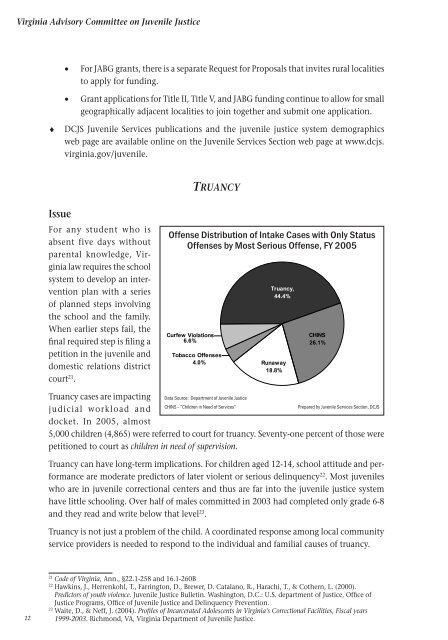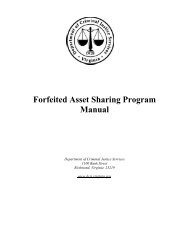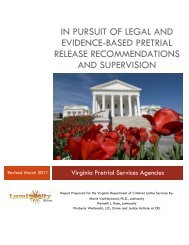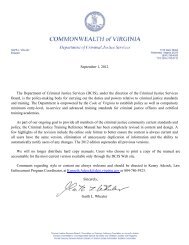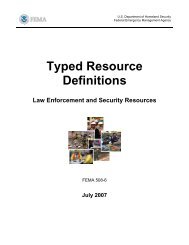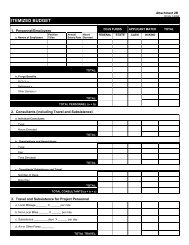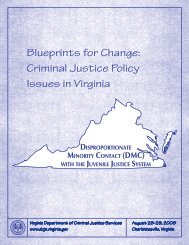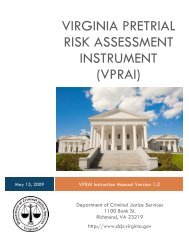2005 Annual Report - Virginia Department of Criminal Justice Services
2005 Annual Report - Virginia Department of Criminal Justice Services
2005 Annual Report - Virginia Department of Criminal Justice Services
You also want an ePaper? Increase the reach of your titles
YUMPU automatically turns print PDFs into web optimized ePapers that Google loves.
<strong>Virginia</strong> Advisory Committee on Juvenile <strong>Justice</strong><br />
• For JABG grants, there is a separate Request for Proposals that invites rural localities<br />
to apply for funding.<br />
• Grant applications for Title II, Title V, and JABG funding continue to allow for small<br />
geographically adjacent localities to join together and submit one application.<br />
♦<br />
DCJS Juvenile <strong>Services</strong> publications and the juvenile justice system demographics<br />
web page are available online on the Juvenile <strong>Services</strong> Section web page at www.dcjs.<br />
virginia.gov/juvenile.<br />
Truancy<br />
Issue<br />
For any student who is<br />
absent five days without<br />
parental knowledge, <strong>Virginia</strong><br />
law requires the school<br />
system to develop an intervention<br />
plan with a series<br />
<strong>of</strong> planned steps involving<br />
the school and the family.<br />
When earlier steps fail, the<br />
final required step is filing a<br />
petition in the juvenile and<br />
domestic relations district<br />
court 21 .<br />
Offense Distribution <strong>of</strong> Intake Cases with Only Status<br />
Offenses by Most Serious Offense, FY <strong>2005</strong><br />
Curfew Violations<br />
6.6%<br />
Truancy,<br />
44.4%<br />
Tobacco Offenses<br />
4.0% Runaway<br />
18.8%<br />
CHINS<br />
26.1%<br />
Truancy cases are impacting<br />
judicial workload and<br />
docket. In <strong>2005</strong>, almost<br />
Data Source: <strong>Department</strong> <strong>of</strong> Juvenile <strong>Justice</strong><br />
CHINS – “Children in Need <strong>of</strong> <strong>Services</strong>”<br />
Prepared by Juvenile <strong>Services</strong> Section, DCJS<br />
5,000 children (4,865) were referred to court for truancy. Seventy-one percent <strong>of</strong> those were<br />
petitioned to court as children in need <strong>of</strong> supervision.<br />
Truancy can have long-term implications. For children aged 12-14, school attitude and performance<br />
are moderate predictors <strong>of</strong> later violent or serious delinquency 22 . Most juveniles<br />
who are in juvenile correctional centers and thus are far into the juvenile justice system<br />
have little schooling. Over half <strong>of</strong> males committed in 2003 had completed only grade 6-8<br />
and they read and write below that level 23 .<br />
Truancy is not just a problem <strong>of</strong> the child. A coordinated response among local community<br />
service providers is needed to respond to the individual and familial causes <strong>of</strong> truancy.<br />
12<br />
21<br />
Code <strong>of</strong> <strong>Virginia</strong>, Ann., §22.1-258 and 16.1-260B<br />
22<br />
Hawkins, J., Herrenkohl, T., Farrington, D., Brewer, D. Catalano, R., Harachi, T., & Cothern, L. (2000).<br />
Predictors <strong>of</strong> youth violence. Juvenile <strong>Justice</strong> Bulletin. Washington, D.C.: U.S. department <strong>of</strong> <strong>Justice</strong>, Office <strong>of</strong><br />
<strong>Justice</strong> Programs, Office <strong>of</strong> Juvenile <strong>Justice</strong> and Delinquency Prevention.<br />
23<br />
Waite, D., & Neff, J. (2004). Pr<strong>of</strong>iles <strong>of</strong> Incarcerated Adolescents in <strong>Virginia</strong>’s Correctional Facilities, Fiscal years<br />
1999-2003. Richmond, VA, <strong>Virginia</strong> <strong>Department</strong> <strong>of</strong> Juvenile <strong>Justice</strong>.


